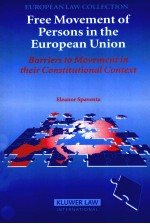

FREE MOVEMENT OF PERSONS IN THE EUROPEAN UNION BARRIERS TO MOVEMENT IN THEIR CONSTITUTIONAL CONTEXTPDF电子书下载
- 电子书积分:9 积分如何计算积分?
- 作 者:DR ELEANOR SPAVENTA
- 出 版 社:KLUWER LAW INTERNATIONAL
- 出版年份:2007
- ISBN:9041124705
- 页数:182 页
Chapter 1. The Rights of Economic Migrants: An Overview 1
1. The Personal Scope of the (Economic) Free Movement Provisions 2
1.1. Article 39 EC and the Definition of 'Worker' 2
1.1.1. Work Seekers 4
1.1.2. When can Article 39 EC be Invoked? 6
1.2. The Personal Scope of Article 43 EC 6
1.3. The Personal Scope of Article 49 EC and the Notion of 'Service' 7
2. The Material Scope of the Free Movement of Persons Provisions: The Rights Granted by the Treaty 11
2.1. The Right to Leave, Enter, Stay and Move 12
2.1.1. The Right of Residence 14
2.2. The Right Not to be Discriminated Against 16
2.2.1. Direct Discrimination 17
2.2.2. Indirect Discrimination 20
3. Examples of Indirect Discrimination in the Context of Free Movement 24
4. Indirect Discrimination and the Free Movement of Services: Mutual Recognition and Double Burden 26
5. The Scope of the Principle of Non-discrimination 27
6. The Family of the Economic Migrant 30
7. Conclusions 32
Chapter 2. Exploding the Boundaries: The Case Law on the Free Movement of Services in the 1990s and Beyond 35
1. The Free Movement of Goods-the Sunday Trading Saga and the Keck Ruling 36
2. Non-discriminatory Barriers to the Provision of Cross-Border Services 42
3.(Un)Lawfully Providing a Service? Challenging the Rules of the State of Establishment 44
4. The Health Care Cases and the Definition of a Service Provided for Remuneration 50
5. A Critical Analysis of the Court's Reasoning 54
6. The Authorization Requirement 58
7. Conclusions 60
Chapter 3. Barriers to the Free Movement of Workers and Establishment Beyond Discrimination 63
1. Non-discriminatory Restrictions to Freedom of Establishment and the Free Movement of Workers 64
2. The Post-Gebhard Case Law 68
3. The Case Law on Free Movement of Capital 70
4. The Gebhard Test, Tax and Social Security Rules 71
5. Conclusions 73
Chapter 4. Providing a Framework to the Free Movement Provisions:The Narrow Approach 75
1. Discrimination, Double Burden and Mutual Recognition 77
2. The Mutual Recognition Approach 80
3. The Narrow Approach as a Prescriptive Model 84
4. Conclusions 88
Chapter 5. Market Access: A Concept in Search of a Definition 89
1. Market Access as (Almost) a Descriptive Model:The Case Law on Persons 90
2. Market Access: A Concept in Search of a Definition? 93
3. Substantial Hindrances to Market Access:An Intuitive View? 95
4. The Gebhard (R)evolution 99
5. Formal Restrictions to Market Access:Not All that Glitters is Gold 102
6. Market Access and the Internal Market 105
6.1. Formal Barriers and Absolute Bans 105
6.2. Formal Barriers and Internal Market 106
6.3. Formal Barriers and Movement 108
7. Conclusions 110
Chapter 6. Union Citizenship 113
1. From Sala to Baumbast: The Tortuous Path Towards Union Citizenship 115
2. The Right to Challenge National Rules Falling Within the Scope of the Treaty and Beyond 123
3. Mr Carpenter as a Citizen 126
3.1. The Purely Internal Situation 127
3.2. Giving Effect to Article 17 EC 128
3.3. The Elimination of Reverse Discrimination Articles 17 and 12 EC 132
4. Conclusions 133
Chapter 7. Mr Gebhard Meets Mr Baumbast: Towards a More Coherent Theory of Free Movement 135
1. Union Citizenship and the Other Free Movement of Persons' Provisions: Creating the 'Fundamental Status' of Union Citizens 137
2. Similarities in Interpretation: The Hermeneutic Technique Adopted by the Court 138
3. Mr Gebhard Meets Mr Baumbast: Towards a Coherent Constitutional Framework 142
3.1. A Right to Exercise an Economic Activity in Another Member State 143
3.2. The Gebhard Case Law 146
3.3. The Different Approach Adopted in Relation to Tax Rules 148
4. Seeking Consistency - the Case Law, the Treaty and the Cross-Border Element 149
4.1. The Cross-Border Element 150
5. Conclusions 153
Table of Cases 157
Bibliography 167
Index 177
- 《三维图解和谐瑜伽书》(美)艾比·埃尔斯沃斯(DR.ABBYELLSWORTH)著;周亚菲译 2013
- 《中国将称霸21世纪吗?》(美)弗格森 N. (Niall Ferguson),亨利·季辛吉(Dr.Henry Kissinger),李稻葵(David Daokui Li),Fareed Zakaria著;廖彦博译 2012
- 《健康自己作主女人魅力十足》(美)DR.丹尼著 2000
- 《让祖父母 HIGH 起来》DR.RUTH K.WESTEIMER WITH PIERRE A.LEHU著;林宪正译 1998
- 《酒店室内设计》(英)埃莉诺·柯蒂斯(Eleanor Curtis)著;林君,王殊隐译 2004
- 《英语语法实例词典》伦哈迪(Dr.A.Leonhardi)著;周弦波,邝启漳编译 1983
- 《知觉学习和发展的原理》(美)埃莉诺·J.吉布森(Eleanor J. Gibson)著;李维,李季平译 2003
- 《格蕾丝:一个美国女人在中国 1934-1974》(美)爱丽诺·麦考利·库珀(Eleanor McCallie Cooper),刘维汉(William Liu)著;傅志爱译 2006
- 《藉口为失败之母:误你一生的杀手》JAMES M.BLEECH DR.DAVID G.MUTCHLER编著;叶静妮译 2001
- 《穿袜子的狐狸》(美)苏斯博士(Dr. Seuss)图文;孙若颖译 2007
- 《Foundations of criminal law》[edited] by Leo Katz 1999
- 《SCHLESINGERS COMPARATIVE LAW》UGO A.MATTEI TEEMU RUSKOLA ANTONIO GIDI 2009
- 《信念共同体:法与经济学的新方法=THE REPUBLIC A NEW APPROACH TO LAW AHD ECONOMICS》(印)考希克·巴苏(KaushilBasu)著 2020
- 《人工智能法学简论=A BRIEF DISCUSSION ON THE LAW OF ARTIFICIAL INTELLIGENCE》孙建伟 2019
- 《国际政治中的中等国家:加拿大=CANADA AS A MIDDLE POWER IN THE INTERNATIONAL POLITICS》钱皓著 2020
- 《国际商法 第8版=INTERNATIONAL COMMERCIAL LAW》张圣翠主编 2020
- 《Law:its origin growth and function》by James Coolidge Carter 1907
- 《国际商务英语》孙莹主编 2013
- 《公司法学》(英)泰勒著 2014
- 《施米托夫论出口贸易 国际贸易法律与实务 上 第11版》克利夫·M·施米托夫,卡罗尔·默里,戴维·霍洛韦等著;冷柏军主译 2014
